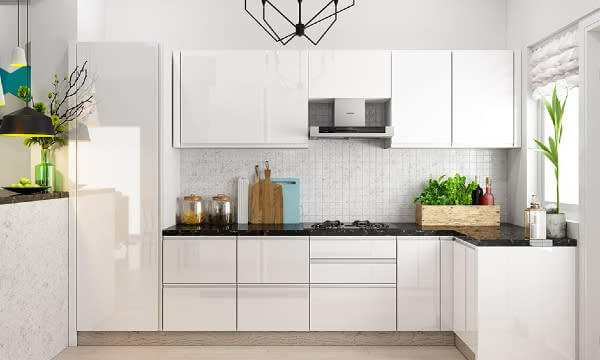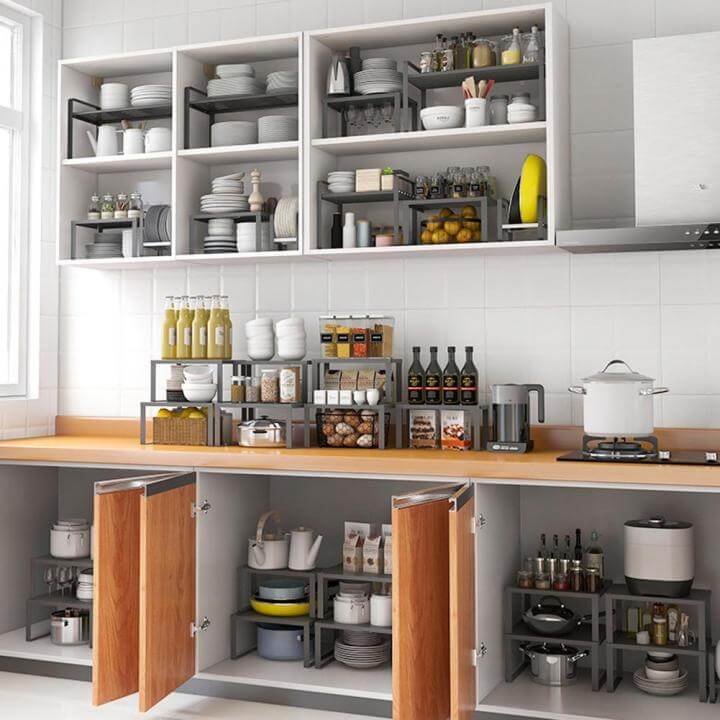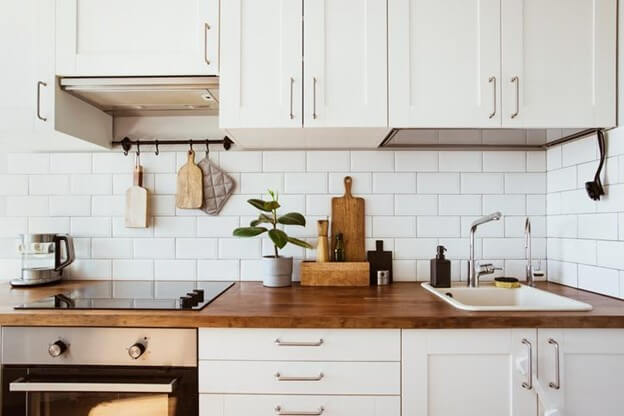A cluttered and disorganized kitchen can make even the simplest cooking tasks feel overwhelming. From struggling to find the right ingredients to dealing with overflowing cabinets, a chaotic kitchen can impact not only your cooking experience but also your overall well-being. Here at Project Neat, we will explore the importance of decluttering your kitchen cabinets and the benefits of kitchen organization. Join us as we delve into practical tips, step-by-step guides, and creative solutions to transform your kitchen into a functional and stress-free space. Let’s embark on a journey to declutter your kitchen cabinets and discover the transformative power of a well-organized kitchen.
Introduction: The importance of Kitchen Cabinet Organization and Decluttering
A cluttered and disorganized kitchen can make even the simplest cooking tasks feel overwhelming. From struggling to find the right ingredients to dealing with overflowing cabinets, a chaotic kitchen can impact not only your cooking experience but also your overall well-being. It’s our goal to explore the importance of decluttering your kitchen cabinets and the benefits of kitchen organization. Join the team here at Project Neat as we delve into practical tips, step-by-step guides, and creative solutions to transform your kitchen into a functional and stress-free space. Let’s embark on a journey to declutter your kitchen cabinets and discover the transformative power of a well-organized kitchen.Having well-organized kitchen cabinets is essential for several reasons. Firstly, it saves you time and frustration. When everything is in its designated place, you can easily find the ingredients, utensils, and tools you need, reducing the time wasted searching through cluttered cabinets. This efficiency in the kitchen allows you to focus on the joy of cooking and meal preparation.Secondly, kitchen cabinet organization promotes a sense of calm and reduces stress levels. A cluttered kitchen can create a chaotic atmosphere, making it difficult to relax and enjoy the cooking process. By decluttering and organizing your cabinets, you create a serene and peaceful environment that enhances your overall cooking experience.Furthermore, a well-organized kitchen is crucial for maintaining hygiene and safety. Cluttered cabinets can harbor dust, debris, and even pests, compromising the cleanliness of your cooking space. By decluttering and organizing your cabinets, you can easily wipe them down, ensuring a clean and sanitary environment for food preparation.Lastly, kitchen organization can lead to cost savings. When your cabinets are cluttered, it’s easy to forget about ingredients or tools that are hidden away. As a result, you may end up purchasing duplicates of items you already have, wasting both money and valuable storage space. By decluttering and organizing your cabinets, you gain a clear inventory of what you have, allowing you to make more informed shopping decisions.In the following sections of this blog post, we will guide you through a step-by-step process to declutter your kitchen cabinets. We will also explore the various benefits of an organized kitchen and provide practical tips for organizing different types of cabinets. Are you ready to transform your kitchen into a well-organized and efficient space? Let’s get started!The step-by-step Guide to Decluttering Your Kitchen Cabinets
Decluttering your kitchen cabinets may seem like a daunting task, but with a step-by-step approach, you can tackle it efficiently and effectively. In this section, we will provide you with a comprehensive guide to decluttering your kitchen cabinets. Follow these steps to transform your cabinets into organized and functional spaces:- Set a Goal: Before you begin decluttering, set a clear goal for what you want to achieve. Do you want to create more space? Improve accessibility? Or simply reduce the overall clutter? Having a specific goal in mind will help you stay focused throughout the decluttering process.
- Empty the Cabinets: Start by emptying all the contents of your cabinets onto a clean and spacious countertop or table. This will allow you to see everything you have and make informed decisions about what to keep and what to discard.
- Sort and Categorize: Create categories for your kitchen items such as cookware, bakeware, utensils, gadgets, and food items. As you sort through each item, ask yourself if it is something you use regularly, if it is in good condition, and if it serves a purpose in your kitchen. Separate your items into three piles: keep, donate/sell, and discard.
- Purge and Declutter: Begin by getting rid of any items that are broken, expired, or no longer needed. Dispose of expired food items and donate or sell any kitchen tools or appliances that are in good condition but no longer serve a purpose in your kitchen. Be ruthless in your decluttering process and only keep items that are essential and meaningful to you.
- Clean and Organize: Once you have decluttered, take the opportunity to thoroughly clean your cabinets. Wipe down the shelves, vacuum any crumbs or dust, and sanitize the surfaces. As you put items back into the cabinets, consider their frequency of use and accessibility. Place frequently used items within easy reach and utilize storage solutions such as dividers, racks, and bins to maximize space and keep things organized.
- Maintain the Organization: To maintain the organization of your kitchen cabinets, establish a system that works for you. Regularly declutter and reassess your items to prevent clutter from building up again. Develop habits of returning items to their designated places after use, and involve your family members in maintaining the organization.

Benefits of an Organized Kitchen
An organized kitchen offers numerous benefits that go beyond just having a tidy space. In this section, we will explore the various advantages of maintaining an organized kitchen. From increased efficiency to improved safety, here are some of the key benefits you can enjoy:- Efficiency in Cooking and Meal Prep: With an organized kitchen, you can streamline your cooking and meal preparation processes. Having clear and accessible storage for ingredients, utensils, and cookware allows you to quickly find what you need, saving you valuable time and energy. This efficiency can make cooking more enjoyable and help you become more productive in the kitchen.
- Reduced Stress Levels: A cluttered and disorganized kitchen can create a stressful environment. It can be frustrating to search for items amidst the chaos and navigate through cluttered countertops. By organizing your kitchen cabinets, you create a calm and serene space that promotes relaxation and reduces stress. Cooking becomes a more enjoyable experience when you have a clear and organized workspace.
- Improved Hygiene and Safety: Cluttered and unorganized cabinets can harbor dust, food debris, and even pests. By decluttering and organizing your kitchen cabinets, you can easily clean and sanitize the surfaces, reducing the risk of contamination. Additionally, well-organized cabinets prevent items from falling or spilling, minimizing the chances of accidents and injuries.
- Cost Savings: An organized kitchen can lead to cost savings in several ways. Firstly, when your cabinets are organized, you have a clear inventory of what you already own. This helps you avoid purchasing duplicate items, saving you money. Additionally, by keeping your cabinets organized, you can prevent food items from expiring or going to waste, reducing food waste and saving on grocery expenses.
- Enhanced Visual Appeal: A well-organized kitchen is visually appealing and creates a sense of order and harmony. When your cabinets are neatly arranged and clutter-free, it can positively impact the overall aesthetic of your kitchen. An organized space also makes it easier to showcase your favorite kitchen items and display them in an attractive manner.
Organizing Tips for Different Types of Kitchen Cabinets
Every kitchen is unique, and different cabinets present their own challenges when it comes to organization. In this section, we will provide you with practical tips and strategies for organizing different types of kitchen cabinets. Whether you have small cabinets, large cabinets, or limited space, these tips will help you make the most of your available storage:- Organizing Small Kitchen Cabinets:
- Utilize vertical space: Install stacking shelves or utilize tension rods to create additional storage space vertically.
- Use drawer dividers: Maximize space in small cabinets by using drawer dividers to separate and organize utensils and small items.
- Hang items on the inside of cabinet doors: Install hooks or adhesive organizers on the inside of cabinet doors to hang small items such as measuring spoons or oven mitts.
- Organizing Large Kitchen Cabinets:
- Group items by category: Create designated zones within your cabinets for different categories such as cookware, bakeware, or food storage containers.
- Utilize pull-out shelves or lazy susans: These rotating shelves make it easier to access items at the back of deep cabinets.
- Use storage bins or baskets: Utilize storage bins or baskets to group and contain items, making it easier to find and access what you need.
- Organizing Cabinets with Limited Space:
- Install under-shelf racks: These racks create additional storage space by utilizing the unused space beneath the shelves.
- Hang pots and pans: Install a pot rack or utilize hooks to hang pots, pans, and lids, freeing up valuable cabinet space.
- Utilize the space above cabinets: If you have cabinets that don’t extend to the ceiling, use that space to store items that are infrequently used or decorative pieces.
- Maximizing Cabinet Space with Organizational Tools:
- Use stackable containers: Stackable containers help maximize vertical space and keep items like food storage containers tidy.
- Install cabinet organizers: Consider installing pull-out shelves, spice racks, or drawer organizers to maximize space and keep items easily accessible.
- Label containers and shelves: Labeling containers and shelves can help you quickly find what you need and maintain an organized system.

Overcoming Common Challenges in Kitchen Cabinet Organization
Organizing kitchen cabinets can come with its fair share of challenges. From finding time to declutter to dealing with limited space, these obstacles can make the task feel overwhelming. In this section, we will address some common challenges in kitchen cabinet organization and provide practical solutions to overcome them:- Finding Time to Declutter and Organize:
- Break it down: Instead of trying to tackle all your cabinets in one go, break the task down into smaller, manageable sessions. Dedicate a specific amount of time each day or week to focus on decluttering and organizing a specific cabinet or area.
- Set a schedule: Create a schedule or checklist to keep yourself accountable and ensure that you allocate regular time for organizing your cabinets. Treat it as a priority and make it a part of your routine.
- Keeping the Cabinets Organized:
- Regular maintenance: Make it a habit to regularly reassess and declutter your cabinets. Set aside time every few months to go through your items and discard or donate anything that is no longer needed or used.
- Assign designated spots: Designate specific spots for each item in your cabinets and make a conscious effort to return items to their designated spots after use. This will help maintain order and prevent clutter from accumulating.
- Dealing with Limited Cabinet Space:
- Maximize vertical space: Use vertical storage solutions such as stacking shelves, hooks, or under-shelf racks to make the most of the available space.
- Utilize alternative storage areas: Look for other areas in your kitchen where you can store items that don’t necessarily need to be in the cabinets, such as a pantry, a kitchen island with storage, or wall-mounted shelves.
- Finding the Right Organizational Tools:
- Evaluate your needs: Assess your specific storage needs and consider the type of items you have in your cabinets. This will help you determine the most suitable organizational tools, such as drawer dividers, pull-out shelves, or storage bins.
- DIY solutions: If budget is a concern, consider DIY solutions using repurposed items like mason jars, shoeboxes, or tension rods. Get creative and think outside the box to find affordable and practical organizational solutions.

